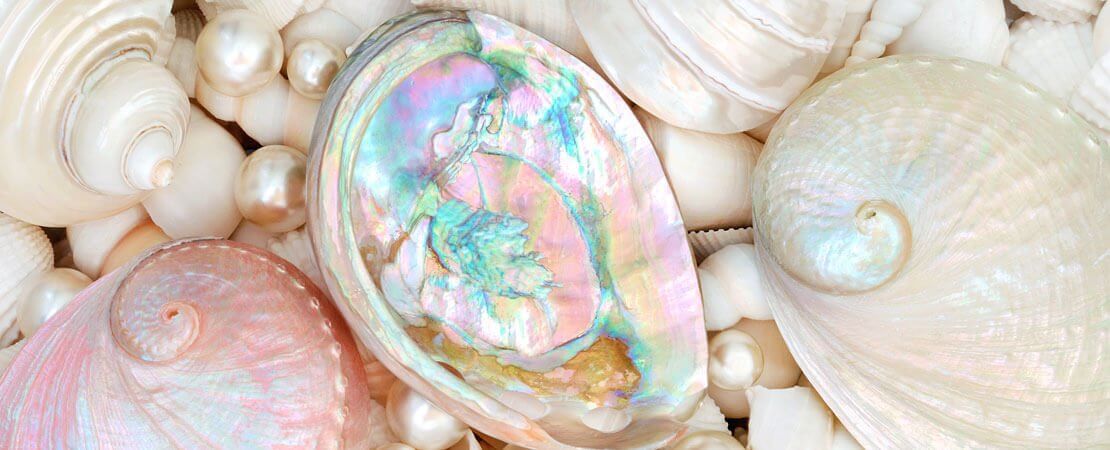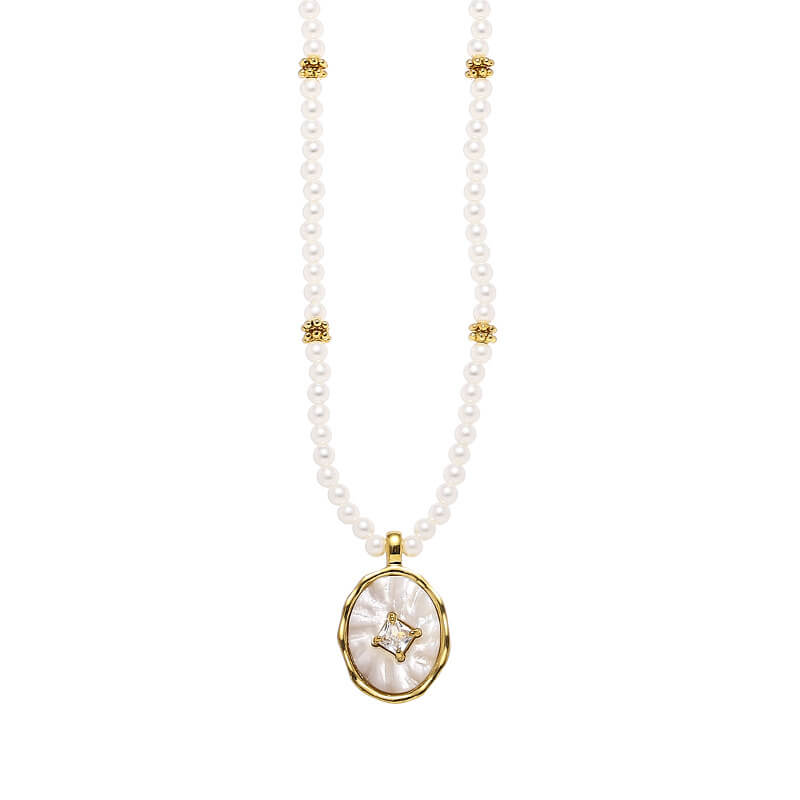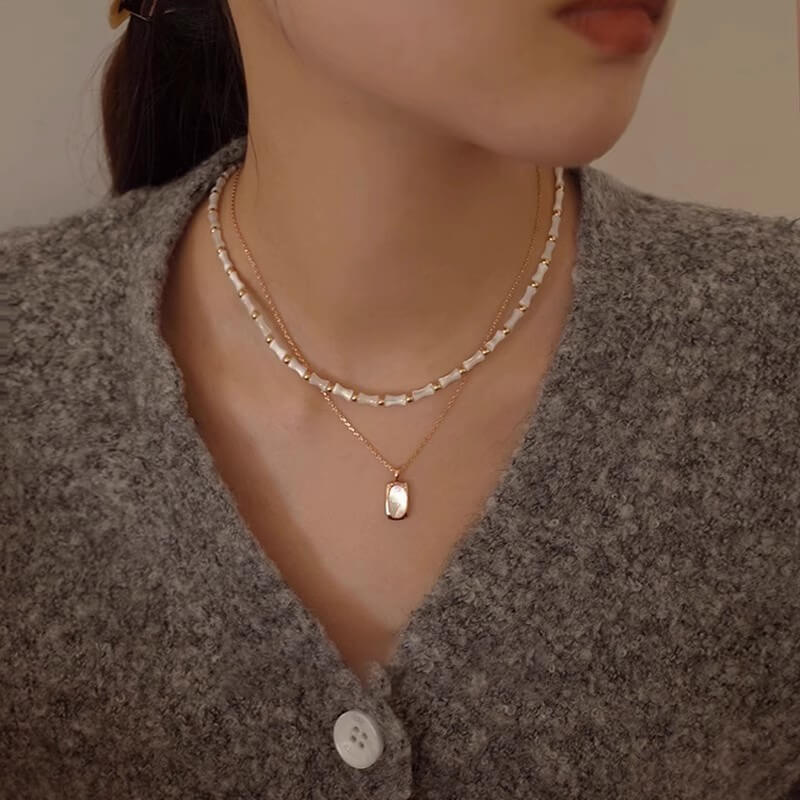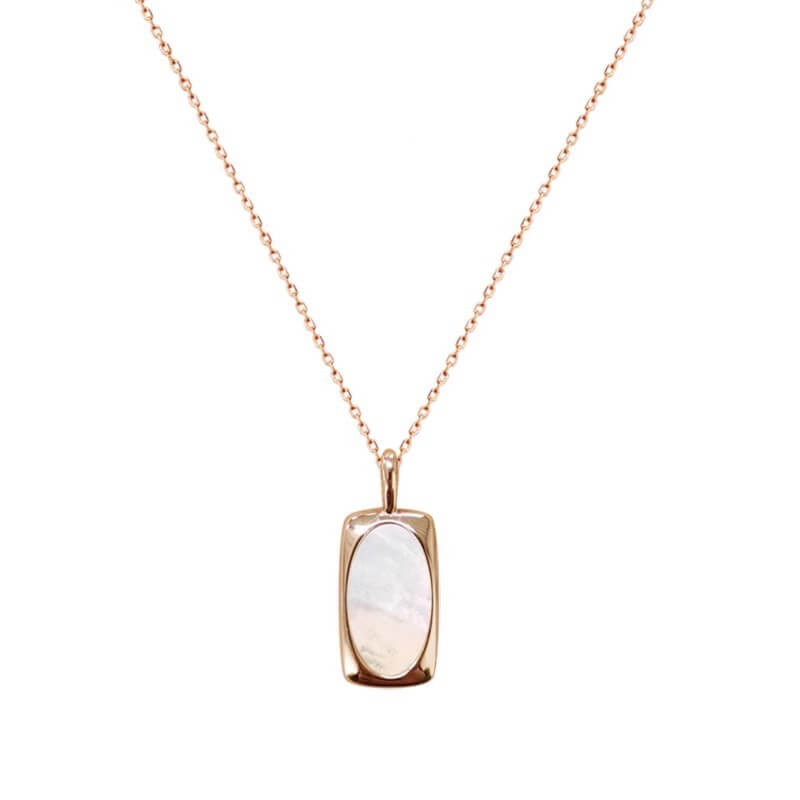Vintage Jewerly Blog
Mother of Pearl: Everything You Need to know
Mother of pearl, this precious gem of nature, combines beauty and extraordinary qualities. Its unique, perfect blend of lightness, strength and durability still fascinates scientists to this day. The mystery lies in its exquisite layered interlocking structure.
It is true that modern engineers and architects can draw boundless inspiration from it, but for the common people, the most captivating aspect of mother-of-pearl is its unparalleled visual charm. The dazzling iridescent luster of mother of pearl from natural creation has inspired countless poets. Moreover, from the grand architectural space to the exquisite mother of pearl earrings, one can always find a trace of its unique brilliance.
Keep on reading, and follow us to explore more charming history, properties, meaning and value that interwoven with mother of pearls.
What is Mother of Pearl?
Mother of pearl, also known as nacre, is the charming shiny lining in the shells of mollusks such as oysters, abalone and freshwater mussels. Its beauty stems from its unique composition and structure. Mother of pearl is essentially an organic-inorganic composite material.
Mollusks secrete nacre through their mantle (the soft tissue inside the shell). The mantle alternately deposits calcium carbonate crystals and shellfish hard proteins into extremely thin layers. As time goes by, these accumulated layers stack up to form the thick nacre that we see. The key point lies in that these tiny, regularly arranged thin layers of aragonite can diffract light. It is precisely this interaction between light and the layered structure that gives rise to the characteristic rainbow-like luster of mother-of-pearl. More importantly, Mother of pearl has a smooth and highly reflective surface and its color changes with changes in the Angle of light.
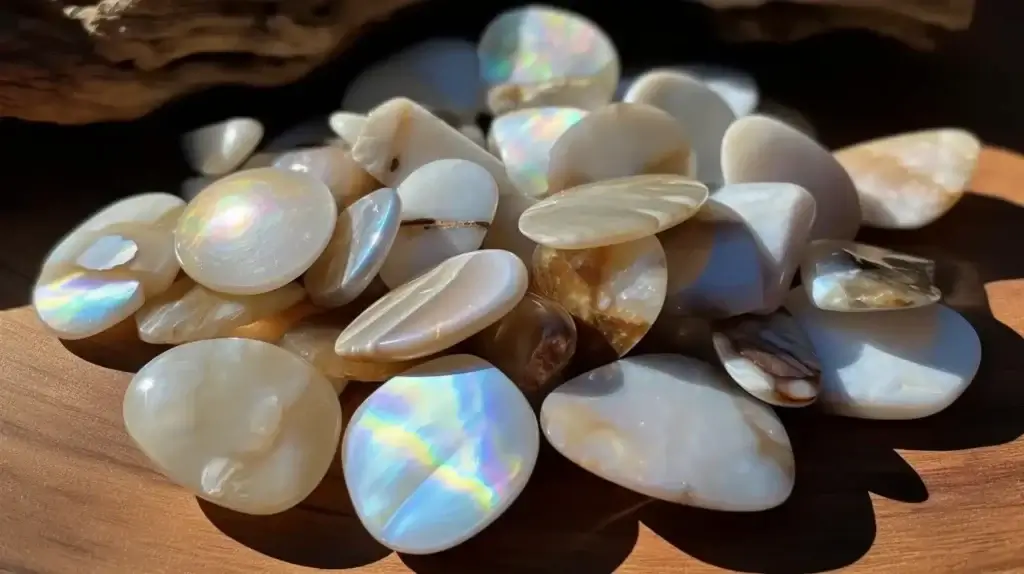
The Properties of Mother of Pearl
Rich color
Mother-of-pearl can present a rich variety of tones, including white, cream, pink, blue, green and even black. There are many factors that affect its color, like the type of mollusk, growth environment conditions, and the presence of trace impurities.
Strength and toughness
Although the main component of mother-of-pearl is fragile aragonite, mother-of-pearl demonstrates outstanding strength and toughness. This is attributed to its unique “brick-mud” microstructure: tiny articulate crystals are closely stacked into thin layers like bricks, and the organic biopolymer spiralizing acts as mortar, combining the crystals together to prevent cracks from spreading through the material. This ingenious combination endows mother of pearl with strength and toughness far exceeding that of its constituent materials themselves.
Charming iridescent luster:
One of the most fascinating properties of mother-of-pearl is its unpredictable iridescent luster. This visual effect, like a flowing rainbow, stems from the wonderful interaction that occurs between the light and its intricate layered structure.
When light shines on the layered structure of mother-of-pearl, a physical phenomenon known as thin-film interference occurs. Therefore, light waves of specific wavelengths are selectively enhanced while the light of other wavelengths is weakened or canceled out. This dynamic rainbow can change dynamically with the alteration of the incident Angle of light or the observer’s perspective, thus allowing us to appreciate the captivating and unique luster on the surface of mother-of-pearl.
Good thermal stability
Mother of pearl nacre has relatively good thermal stability, which means it can withstand high temperatures without easily decomposing. This characteristic is crucial for mollusks living in warm or sea areas with fluctuating water temperatures, as it can protect their shell structures from natural temperature changes.
Potential fluorescence
Under certain lighting conditions (such as ultraviolet radiation), some nacre may exhibit fluorescence and emit visible light. Its occurrence and intensity mainly depend on the presence of trace impurities and specific formation environmental factors.

A long history of Mother of Pearl Nacre
This pursuit of mother of pearl has also crossed the mainland along with the pace of trade and exploration. At least since Marco Polo’s famous journey to the East in 1292, the unique charm of mother of pearl has deeply attracted the skilled craftsmen and merchants on the European continent, and has become another brilliant bond connecting the art and trade of the East and the West.
Therefore, the significance of the mother of pearl is multi-dimensional. It is both a miracle of the perfect combination of lightness and strength in nature and a gentle force that brings peace to both body and mind. It is also a symbol of sacred motherhood and inner wisdom, providing bright guidance and firm protection. It has also been refined as a symbol of wealth and cultural treasure that transcends time and space in human civilization, carrying the common pursuit of beauty, sanctity and immortality by different ethnic groups. It is both a material treasure and a spiritual lighthouse.
The Meaning of Mother of Pearl Nacre
This pursuit of mother of pearl have also crossed the mainland along with the pace of trade and exploration. At least since Marco Polo’s famous journey to the East in 1292, the unique charm of mother of pearl has deeply attracted the skilled craftsmen and merchants on the European continent, and has become another brilliant bond connecting the art and trade of the East and the West.
Therefore, the significance of mother of pearl is multi-dimensional. It is both a miracle of the perfect combination of lightness and strength in nature and a gentle force that brings peace to both body and mind. It is also a symbol of sacred motherhood and inner wisdom, providing bright guidance and firm protection. It has also been refined as a symbol of wealth and cultural treasure that transcends time and space in human civilization, carrying the common pursuit of beauty, sanctity and immortality by different ethnic groups. It is both a material treasure and a spiritual lighthouse.

Is Mother Pearl a real pearl?
No, Mother of Pearl itself is not a “true pearl”. However, both are of the same origin and are composed of nacre secreted by mollusks.
Actually, mother of pearl refers to the hard, smooth and iridescent substance that covers the inner walls of mollusk shells. This layer of nacre is a natural protective layer for mollusks and is widely present inside the shells of many shellfish, used to defend against the invasion of parasites and irritants. Therefore, mother-of-pearl is a relatively common and easily accessible material.
Pearl VS Mother of Pearl
Although pearls and mother-of-pearl are composed of the same substance (nacre), there are significant differences in their form, formation method and value:
Form
- Mother-of-pearl: It is a layered substance that covers the inner walls of shells. It is not an independent individual but a part that constitutes the shell. As a raw material, it is relatively abundant and can be cut, polished and inlaid into various shapes including buttons, inlaid pieces, jewelry parts.
- Pearl: It is an independent, spherical and organic gemstone. It is a single and complete entity formed by the layer-by-layer deposition of nacre around the core foreign matter.
Formation and scarcity
- Mother-of-pearl: It is continuously secreted by mollusks during their natural growth process and covers the entire inner wall of the shell. Therefore, it is a common and relatively accessible material, and its price is relatively affordable.
- Pearls: Their formation requires foreign substances to invade soft tissues, and not all shellfish can produce pearls. Even artificially cultivated pearls require several years for the nacre to mature layer by layer through sedimentation. The complexity and low probability of this formation make pearls, especially natural pearls, extremely rare and precious. Thus, the market value of pearls is much higher than that of mother-of-pearl.
Application
- Mother-of-pearl: Thanks to the rich source of mother of pearl, it is widely used in inlaying techniques, ornaments, musical instrument inlaying, buttons, etc., and is an important decorative raw material.
- Pearl: Its core value lies in its rarity, roundness, luster, size and color as an independent gemstone. It is mainly used for making jewelry like necklaces, earrings, rings, etc.
How to Use Mother of Pearl?
With its unique warm, iridescent and energy properties, mother of pearl has become a widely popular material and is widely used in various handicrafts and practical items:
Personal decoration and wear: The most common applications are in jewelry such as pendants, earrings, and ring Settings, as well as adding an elegant luster to clothing, watch dials, and buttons.
Home and art decoration: Its exquisite textures are inlaid on high-end furniture, Musical Instruments like guitar fingerboards, piano key decorations), handicrafts, art tools and various decorative items.
Architecture and interior design: Mother-of-pearl is even made into decorative floor tiles, luxurious countertops, and distinctive backsplashes that can bring dynamic and ever-changing light and shadow effects to the living space.
Is the Mother pearl considered a gemstone?
Mother of Pearl is often classified under the category of “gemstones”, but a more precise classification is organic gemstones. This means that it is not a mineral formed in the Earth’s crust but a natural substance secreted by living creatures.
Similar to pearls, amber, coral and ivory, mother-of-pearl originates from biological processes. It is generally regarded as a semi-precious material. Compared with precious mineral gemstones such as diamonds and rubies, as well as natural pearls themselves, mother-of-pearl is more abundant in production and relatively easier to obtain. This makes it a more economical and versatile choice in high jewelry and decorative arts.
Despite its more affordable price, mother-of-pearl carries a historical background related to luxury and royalty. Its greatest charm lies in its unparalleled adaptability and multi-faceted nature. Its gentle and ever-changing iridescent luster can be used from classic elegance to free romance.
FAQ about mother of pearl
Where does mother of pearl come from?
Actually, the mother of pearl is an organic substance that comes from the inner lining of mollusks’ shells. Mother of pearl has a charming shiny lining, and you can find it inside the shells of mollusks like oysters, mussels, abalone, and snails!
Is mother of pearl expensive
The mother of pearl is not expensive; it’s an economical choice for jewelry. Since the mother of pearl is a lining on the inner shell of a mollusk, most mollusk can form the mother of pearl with time goes by.
Can I take a bath with mother-of-pearl jewelry?
It is strongly recommended to avoid wearing mother-of-pearl jewelry when taking a bath or swimming.
Although mother-of-pearl originated from water, this by no means implies that it can withstand the water we come into contact with daily, especially bath water containing chemicals.
Long time soaking may cause water to seep into the tiny pores of the mother pearl. This may cause the material to expand, increase the internal structural stress, and eventually lead to cracks or even fragmentation.
Cleaning and care products such as soaps and shampoos all contain chemical components. These substances can corrode the fragile, lustrous surface of mother-of-pearl, causing it to lose its luster. So, please take it off before taking a bath, swimming, doing housework, or sports, and wipe it clean gently with a soft, dry cloth once it gets wet.
How to clean mother of pearl?
The mother of the pearl should be wiped down with clean dampness to remove sweat and dirt. You can also gently brush with a soft toothbrush. Remember to keep the nacre away from objects that may hurt it.

